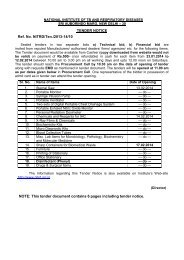The Indian Journal of Tuberculosis - LRS Institute of Tuberculosis ...
The Indian Journal of Tuberculosis - LRS Institute of Tuberculosis ...
The Indian Journal of Tuberculosis - LRS Institute of Tuberculosis ...
You also want an ePaper? Increase the reach of your titles
YUMPU automatically turns print PDFs into web optimized ePapers that Google loves.
14 A.K. CHAKRABORTY ETAL<br />
SCC would be 49.7% (situation I). <strong>The</strong><br />
corresponding efficiency for a DTP where all the<br />
cases are put on SCC would work out to be 78.9%<br />
(situation XI). For situations II to X, the expected<br />
sputum conversion could be calculated to be<br />
anywhere between 52.6% and 75.9%.<br />
DTP efficiency under mixes<br />
After bringing in the additional factor <strong>of</strong><br />
efficiency <strong>of</strong> case-finding, the estimated<br />
proportions <strong>of</strong> cases converted out <strong>of</strong> the<br />
potentially diagnosable cases (DTP efficiency)<br />
are presented in Col. 8 <strong>of</strong> Table 3. <strong>The</strong> DTP<br />
efficiency ranges from 16.4% to 26.0%.<br />
Compliance & treatment efficiency<br />
<strong>The</strong> above computations made respective to<br />
the rates <strong>of</strong> compliance, in cases put on SR and<br />
SCC at compliance levels <strong>of</strong> 1 to 4 are given in<br />
Tables 1 and 2 respectively. Estimates <strong>of</strong><br />
treatment efficiency with hypothetically imposed<br />
improvements in the rate <strong>of</strong> compliance are given<br />
in Tables 4 & 5. Assuming that all the cases are<br />
put on 100% SR or 100% SCC at level 4, (i.e.,<br />
with 80% or more <strong>of</strong> drug consumption), the<br />
treatment efficiency would be 73.3% & 87.8%<br />
respectively (not on Table). However,<br />
considering it to be an unrealistic situation, four<br />
different assumptions on compliance structure<br />
are worked out, with upto 70% <strong>of</strong> cases being<br />
compliant at level 4 (Table 4). In this exercise, the<br />
rates <strong>of</strong> compliance are gradually decreased at<br />
the lower levels <strong>of</strong> compliance with proportionate<br />
increase <strong>of</strong> the rates at the higher levels. Sputum<br />
conversion under the varying proportions <strong>of</strong><br />
mixes with SR and SCC are then worked out,<br />
Table 4. Treatment efficiency* by varying proportional distribution <strong>of</strong> cases on SR<br />
& SCC at different compliance levels<br />
Proportion <strong>of</strong> Cases complying at (%) (a)<br />
On SR<br />
Levels Current (:)<br />
compliance<br />
Compliance hypothetically varied<br />
1<br />
37 10 10 5 5<br />
2 10 20 10 10 10<br />
3 8 20 20 20 15<br />
4 45 50 60 65 70<br />
Overall 100 100 100 100 100<br />
(49.71) (57.86) (60.43) (63.01) (64.30)<br />
(Overall percentage <strong>of</strong> cases sputum negative in brackets)<br />
(b) On SCC<br />
1 20 10 5 5 5<br />
2 4 10 10 5 5<br />
3 20 20 20 25 20<br />
4 56 60 65 65 70<br />
Overall 100 100<br />
(78.86) (80.81)<br />
(Overall percentage <strong>of</strong> cases sputum negative in brackets)<br />
100<br />
(82.39)<br />
100<br />
(83.01)<br />
100<br />
(83.44)<br />
(:) Observed from recent operational studies (Ref 10,11). See Tables 1 & 2; * Treatment efficiency-negative status<br />
<strong>of</strong> cases at the end <strong>of</strong> treatment among cases diagnosed in DTP, computed on the basis <strong>of</strong> respective sputum<br />
conversion rates for compliance given in columns 2 to 6 <strong>of</strong> parts a & b

















